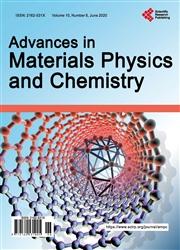Investigation of Nickel Phthalocyanine Thin Films for Solar Cell Applications
引用次数: 4
Abstract
Ni-Phthalocyanine thin films were thermally evaporated with different substrate temperatures (300 - 450) K on (silicon wafer, glass) substrates. The chemical bonds of NiPc powder were investigated by FTIR spectrum, which introduce good information for NiPc bonds and their locations. The optical properties have been studied by UV-Visible, and Photoluminescence (PL) Spectra. The NiPc thin films have direct gap for all samples. The values of energy gap which is calculated by PL spectra are lower than those calculated by Tauc equation. It is found there are three activation energies, the mobility and concentration of carriers have been measured and, the NiPc films are p-type. P-NiPc/n-Si HJ solar cell was fabricated at substrates temperatures (300, 400) K. From I-V and C-V characteristic, abrupt junction has been found, photovoltaic characteristics have been observed with Voc of (0.335 - 0.415) V, and Isc of (2.77 - 4.26) μA, and the efficiency of (3.08 - 5.03)% at room temperature and substrate temperature (300, 400 K) and under illumination of 55 mW/cm2 using Halogen lamp. Ideality factors of the junction increase from (0.61 - 0.73) and barrier height increases from 2.53 eV to 3.69 eV while shunt resistance decreases from 3.76 KΩ to 2.59 KΩ and series resistance decreases slightly from 0.24 KΩ to 0.23 KΩ. The fill factor decreases from 0.46 to 0.4 with the increase of substrate temperature.用于太阳能电池的酞菁镍薄膜的研究
在不同的衬底温度(300 - 450)K下,在(硅片,玻璃)衬底上热蒸发镍酞菁薄膜。利用FTIR光谱研究了NiPc粉末的化学键,为NiPc键及其位置提供了良好的信息。利用紫外可见光谱和光致发光光谱研究了其光学性质。NiPc薄膜对所有样品都有直接间隙。用PL谱计算得到的能隙值比用Tauc方程计算得到的要低。结果表明,制备的NiPc薄膜具有三个活化能,载流子的迁移率和浓度均为p型。在衬底温度为(300,400)K的条件下制备了P-NiPc/n-Si HJ太阳能电池。从I-V和C-V特性可以观察到突变结,光伏特性为(0.335 ~ 0.415)V, Isc为(2.77 ~ 4.26)μA,在室温和衬底温度为(300,400 K)和55 mW/cm2卤素灯照明下的效率为(3.08 ~ 5.03)%。结的理想系数从(0.61 ~ 0.73)增加,势垒高度从2.53 eV增加到3.69 eV,并联电阻从3.76 KΩ降低到2.59 KΩ,串联电阻从0.24 KΩ略微降低到0.23 KΩ。随着衬底温度的升高,填充系数从0.46减小到0.4。
本文章由计算机程序翻译,如有差异,请以英文原文为准。
求助全文
约1分钟内获得全文
求助全文

 求助内容:
求助内容: 应助结果提醒方式:
应助结果提醒方式:


